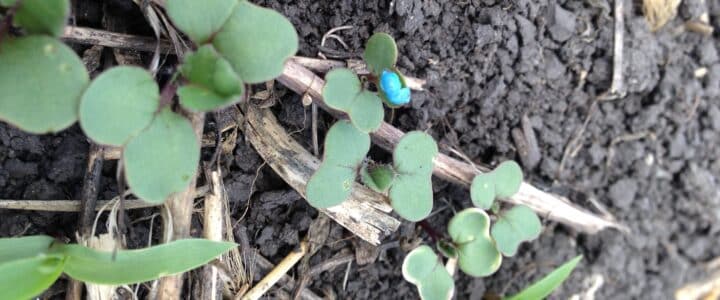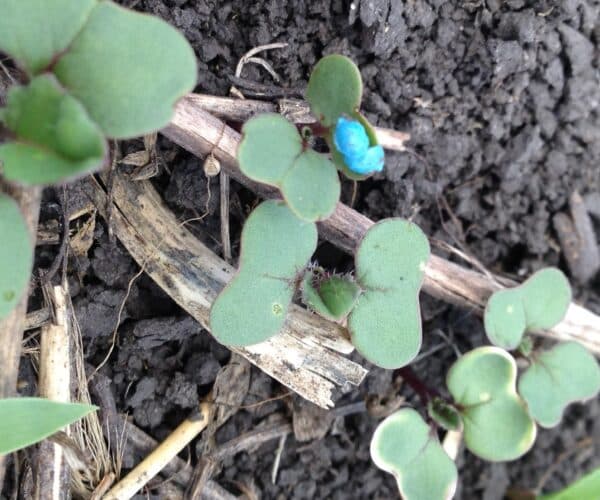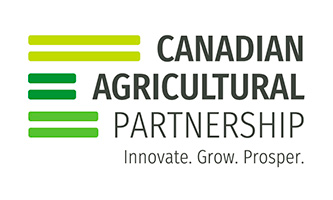Farmers, agronomists and researchers are curious if there are better solutions to their challenges. They also all want science-based knowledge to inform their critical decisions.
The Manitoba Canola Growers’ Canola On-Farm Research Program is one way for all parties to achieve this. Driven by the goal of producing the best science-based knowledge to inform critical decisions, this program increases collaboration between Manitoba farmers, agronomists and researchers. It follows the scientific method of testing a hypothesis with a specific approach to generate relevant and valuable information that match farm priorities.
In 2024, the program added a phosphorus source experiment to its list of trial types, and included a new field scale flea beetle management trial to complement a small plot research project already underway. In addition, this program continued to build the multi-year datasets on nitrogen rates, seeding rates and seed-placed fertilizer toxicity trials. In total, there were 37 testing locations involved in the program in 2024, with good distribution across the canola growing region of the province.
The three nutrient management-focused trials from the 2024 Canola On-Farm Research Program Report are featured below. More information on the program and its goals, partners and summary reports on the Manitoba Canola Growers’ website.
Apply this research on your farm
- Read the 2024 Canola On-Farm Research Program Report and see which learnings and details may apply to your operation.
- Set a realistic yield goal for each field and fertilize appropriately for it.
- Use regular soil tests to help evaluate current soil nutrient status.
- Consider joining the on-farm network in Manitoba or Saskatchewan.
- Commit to keeping good records every year to accurately assess outcomes from past seasons and help inform future seasons.
Canola nitrogen rate trial
Canola requires significant nitrogen for proper growth and development, and the amount of available forms of nitrogen can vary by management and growing season conditions. A better understanding of canola nitrogen use on a farm level provides the best chance of productivity, profitability and sustainability.
For these reasons, this trial examined if nitrogen fertilizer rates currently being used for canola in Manitoba are sufficient to optimize yield and nitrogen efficiency. The five locations (sites) in 2024 brought the total number of sites for this trial up to 15 over three years (2022-2024). However, since this protocol will run again in 2025, the following results should be considered preliminary.

In this protocol, a randomized complete block trial was carried out with three treatments and four replicates (totaling 12 equipment-width-by-field-length-sized strips). The three treatments were:
- Reduced nitrogen rate (75% of what is normally used on that field)
- Standard nitrogen rate (100% of what is normally used on that field)
- High nitrogen rate (125% of what is normally used on that field)
Nitrogen sources and placement was kept consistent across nitrogen rates and what each farmer was already using on their field. As a results trials were completed with four different nitrogen sources (UAN, urea, anhydrous and ESN) and two different placements.
All site data, including plant count, tissue testing and grain moisture measurements for all three treatments, as well as monthly daily temperatures and rainfall accumulations are available in MCGA’s 2024 Canola On-Farm Research Program Report.
Results, outcomes and considerations
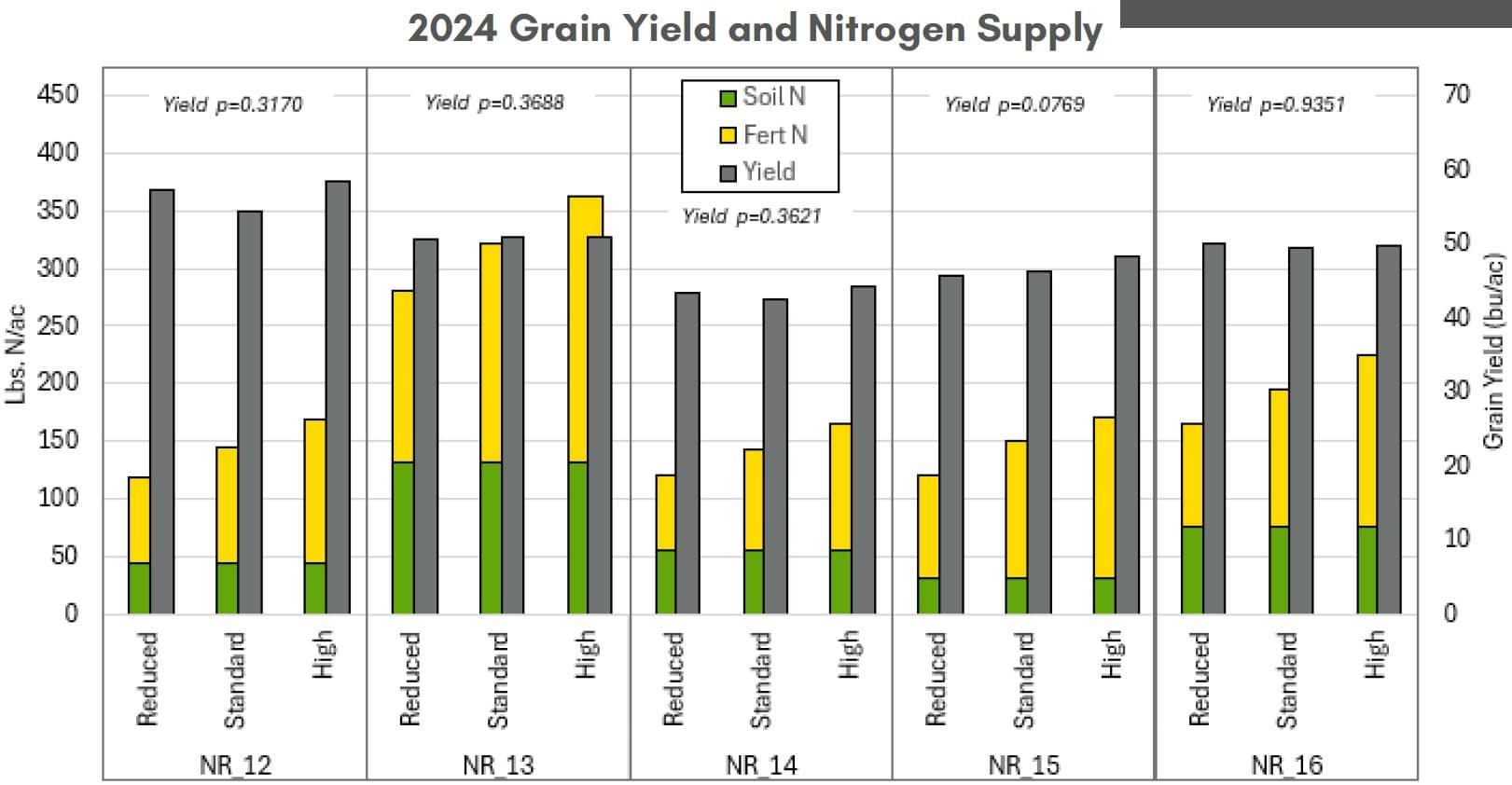
The 2024 canola yields ranged from 42 to 58 bushels per acre but there was no significant effect of nitrogen rate on yield at any site. This suggests that at these sites in the 2024 growing season nitrogen was not the yield-limiting factor and current rates being used were sufficient for the yield being achieved. Yield-limiting factors that were likely at play in these 2024 sites include high levels of blackleg and verticillium stripe as well as unfavorable environmental conditions early in the season.
Further analysis revealed that the average amount of nitrogen supplied to the canola crop per bushel of grain yield across the five 2024 trial sites was 3.8 pounds of nitrogen per bushel, with a range of 2.1 to 7.1 pounds of nitrogen per bushel. Because grain yield was not significantly increased when nitrogen rates increased, as the amount of nitrogen fertilizer supplied to the crop increased the efficiency of nitrogen was reduced at all sites, reducing economic returns.
The lead trial researcher noted that this trial also emphasized the importance of setting realistic yield goals for each field and then choosing an appropriate fertilizer rate accordingly, staying in canola’s 2.5 to 3.5 pounds of nitrogen per bushel of target yield for Manitoba. Implementing 4R Nutrient Stewardship Practices of using the Right place, Right time and Right place when applying the Right rate will also help maximize efficiency.
When considering all the three years (2022-2024) of data from this nitrogen rate trial, the majority (94%) of sites have reported no significant increase in grain yield with a 25% increase in nitrogen rate (at 95% confidence).
Related nutrient management research
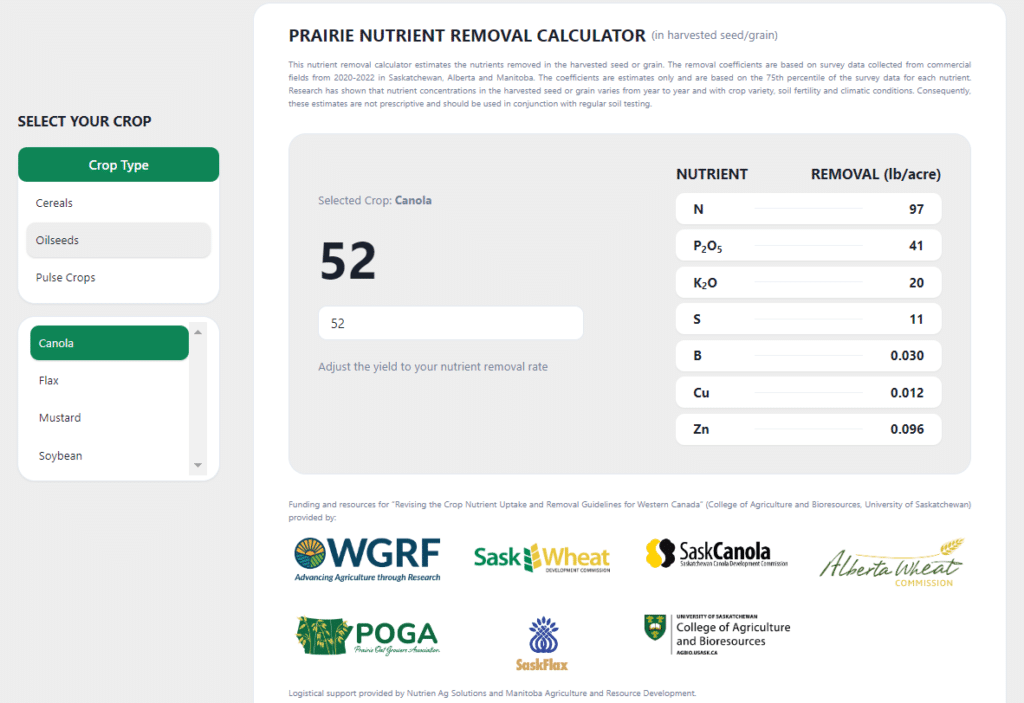
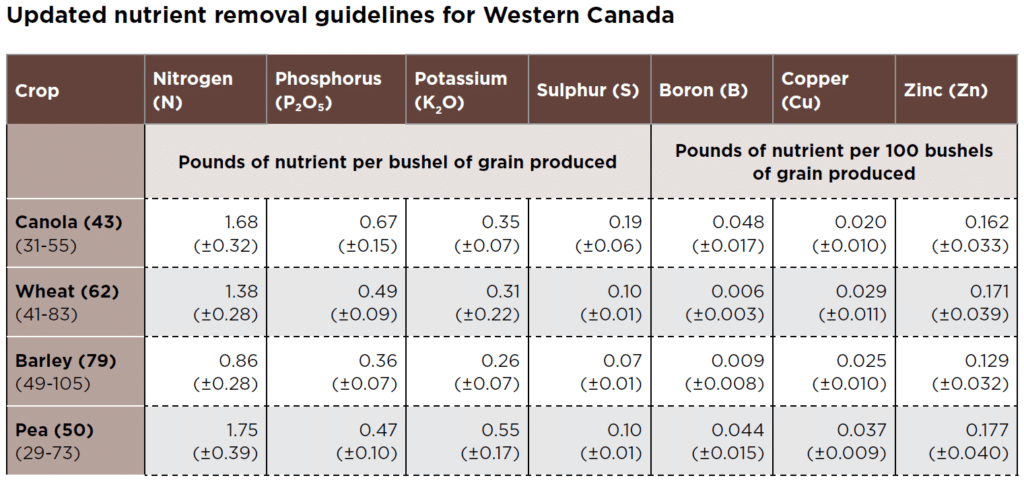
A couple key studies and blogs that investigate key nutrient management aspects are:
- Revising the crop nutrient uptake and removal guidelines for Western Canada project which features the updated crop nutrient uptake and removal guidelines for Western Canada table below and the Prairie nutrient removal calculator below.
- The research highlighted that nutrient removal estimates are an additional tool for assessing nutrient addition required to maintain or build soil fertility levels. Crops are not able to extract all the total nutrient available in the soil (i.e., soil plus added fertilizer) and thus estimates of available nutrient(s) should be greater than estimates of nutrient removal to maintain soil nutrient levels.
- It also suggests regular soil testing is a critical tool for assessing current soil nutrient status and determining appropriate fertilizer application rates to achieve crop yield goals.
- Revisiting nitrogen fertilizer recommendations for Saskatchewan: Are we measuring the right soil nitrogen pool project, which concluded that current soil test recommendations provide an acceptable measure of biologically available nitrogen.
- It also notes that although the response of wheat and canola to fertilizer nitrogen varied between years and sites, trends suggested that the largest response in yield occurred with the first increment of applied nitrogen (i.e., the 0.5´ the soil test recommendation) with further increases at the 1´ soil test recommendation rate.
- Statistically significant yield increases often were not observed above the 1´ rate, suggesting that current soil test recommendations provide an acceptable measure of biologically available nitrogen, with the understanding that weather can strongly influence nitrogen responses.
- The Do nitrogen fixation products provide an economic benefit? Hub blog
- The Intriguing product and rate outcomes from on-farm trials Hub blog
Canola phosphorus source trial
Canola requires large amounts of phosphorus, especially during early growth stages. This early season plant demand along with the immobility of phosphorus in the soil makes it a challenge to balance of placing phosphorus close enough to the canola seed to be accessible, but not cause toxicity issues. The canola phosphorus source trial aims to assist Manitoba farmers in sorting through some of the phosphorus fertilizer products that claim to provide good nutrient availability and seed safety.
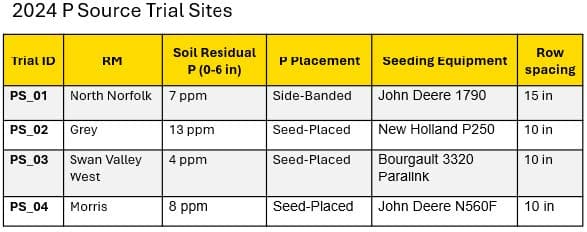
To do this, a randomized complete block trial was carried out in canola fields with four treatments and four replicates (totaling 16 equipment-width-by-field-length-sized strips) at four different locations across the province.
Farmers tested two different phosphorus fertilizer sources that they were interested in at the standard rate for their field as well as a high rate to help evaluate seed safety and phosphorus availability to the crop between sources. Each of the trial locations in 2024 tested different sources of phosphorus. The four phosphorus source comparisons testing in this trial were:
- 10-34-0 compared to ALPINE G22
- MAP 11-52-0 compared to MST 9-43-0-16
- MAP 11-52-0 compared to Synchro Crytal Green
- TopPhos 3-22-0-6 compared to S15 13-33-0-15
One untreated control that didn’t contain phosphorus (not replicated) was also included to characterize the phosphorus responsiveness of the field.
The results of the individual sites are available in the 2024 Canola On-Farm Research Program Report. Due to a limited dataset (from only one year and four sites), all results presented are preliminary and caution should be used when interpreting and making management decisions. Also note that phosphorus availability to canola is highly dependent on environmental conditions during the growing season. Additional site details, including environmental conditions and the phosphorus tissue, biomass (at rosette), grain moisture and yield values are presented in the report.
The trial will run again in 2025 field season.
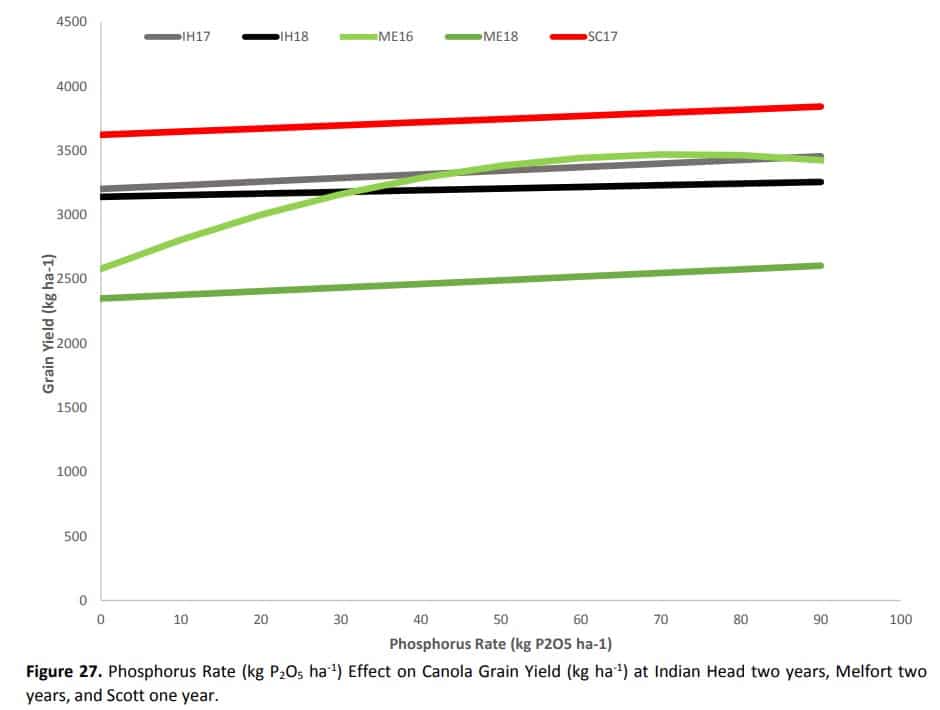
Additional phosphorus management research
Some other phosphorus management project on the Hub to check out includes:
- Enhancing canola production with improved phosphorus fertilizer management, which concluded that placing phosphate fertilizer in the seed row has its challenges because seed damage can occur at fairly low rates. Rather than short the crop with a low seed-placed rate, this study found that the full recommended rate placed outside the seed row is the better option. (see graph)
- Impact of traditional and enhanced efficiency phosphorus fertilizers on canola emergence, yield, maturity and quality, concluded that canola yield generally increased with moderate rates of phosphorus application, but there was little difference among phosphorus sources in their effects on canola seed yield. Where seedling damage occurred, use of polymer coated MAP (monoammonium phosphate) reduced the risk. It also reported that canola could compensate for seedling damage if stands were not reduced below critical levels. Where stand density was low, seed yields declined and maturity was delayed due to seedling toxicity.
- The results from the Demonstrating 4R phosphorus principles in canola work supported the recommendation of banding or seed-placing phosphorus during the seeding operation as opposed to broadcasting.
Seed-placed fertilizer toxicity trial
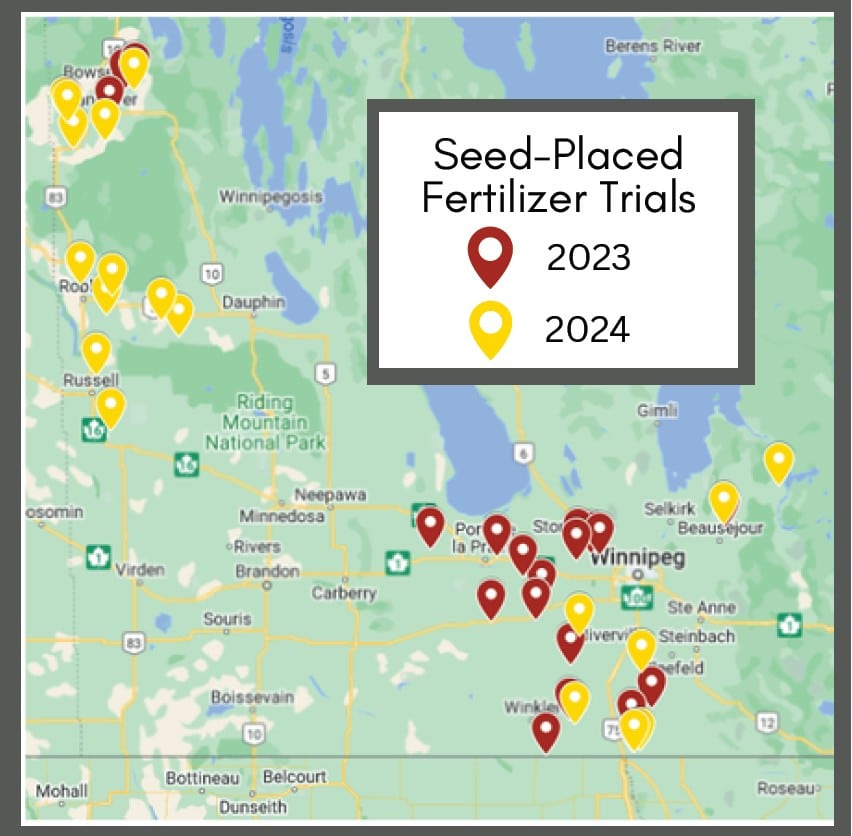
With current recommended maximums for safe seed-placed phosphorus and sulphur fertilizers being much lower than crop uptake requirements, along with a preference for single-pass seeding systems and low disturbance openers, some farms are testing the limits for safe seed-applied fertilizer levels. Fertilizer toxicity is highly dependent on a number of environmental and management factors and their interactions that can vary with the growing season. This seed-placed fertilizer (SPF) toxicity trial examines the major factors across Manitoba canola acres that are contributing to seed-placed fertilizer toxicity.
This trial is replicated by location, with one replicate at each location aiming for a large number of testing locations. This trial design allows for a wider range in testing factors such as, environment (soil/rainfall), equipment (row spacing, openers, seed-bed utilization, or SBU), and agronomic practices (fertilizer sources and rates). This trial is focused on understanding how these factors, alone and in combination, are influencing canola seed-toxicity from seed placed fertilizer.
The specific treatments are:
- No seed-placed fertilizer
- Standard seed-placed fertilizer (100%)
- High seed-placed fertilizer (150%)
To be able to conduct a strong multivariate analysis on this data set there is a target location number of 50. In the two years (2023-2024) that this trial was been running, 39 locations across Manitoba have been tested and this trial will continue in 2025 and 2026. Preliminary results from these sites are available in the 2024 Canola On-Farm Research Program Report.
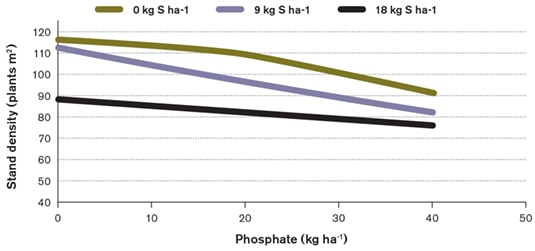
Supplemental seed-placed toxicity studies
For more research on this topic, visit:
- Reducing toxicity of seed-placed phosphorus fertilizer in canola
- Improving nutrient management in canola and canola-based cropping systems
- Canola seed safety and yield response to novel phosphorus sources in Saskatchewan soils
Consider joining the on-farm network
There are lots of great opportunities to get involved in an on-farm program, if you are interested. Options in Manitoba and Saskatchewan are provided below. Research programs and priorities that Alberta Canola is involved with are on their website.
Alternatively, you can conduct an on-farm trial on your own farm by yourself. The Quick tips for on-farm trials Canola Watch fundamentals article will provide basic steps for effective on-farm trials, as well as links to data collection sheets and simple statistical evaluation tools, if you’re interested.
Manitoba
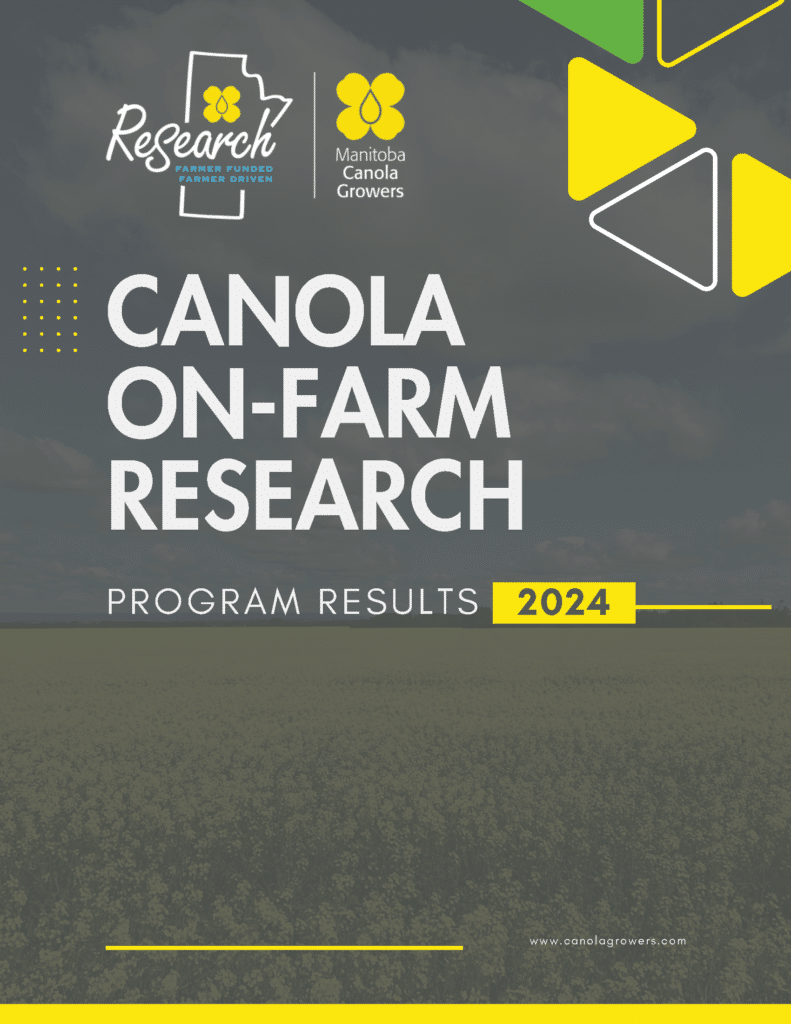
If you would like to get involved with MCGA’s Canola On-Farm Research Program contact Amy Delaquis or Kendall Baker, whether you are a(n):
- Canola grower that is interested in participating, or have a trial idea for our on-farm program.
- Agronomist that is interested in working with MCGA as an Agronomic Partner to work with farms to establish, manage and harvest research trials.
- Researcher interested in collaborating with the Canola On-Farm Research Program to complement your research program.
Saskatchewan
SaskOilseeds will be working closely with the Western Applied Research Corporation (WARC) to assist with development of the project, implementation, measurement, harvest and analysis of the data for the On-Farm Research Trials program. SaskOilseeds and WARC will engage as needed with local agrologists to support the projects.
On-Farm Research Trials program is available to registered canola growers in good standing. To read more see the frequently asked questions. For more information, or to participate in the program, contact Kaeley Kindrachuk. To apply to be a Top Notch Farming Trials Producer, just complete the application on this page by Feb 15, 2025. SaskOilseeds will follow up with applicants after this date. Required fields are noted.
Published January 31, 2025


